
Everyone loves a Labrador Retriever!
A quintessential family dog, they have become a symbol of kinship in America.
This breed thrives in most environments, highly adaptable to each home, and these clever dogs have also found roles as therapy and service pets; although they are most often seen as a loving family dog.
Labrador Retrievers are known the world-over for their good-natured, fun and playful personalities. They love to be around people, either receiving cuddles on the couch or playing in the park.
Could this breed be a good match for your family? Keep on reading to find out more…
TABLE OF CONTENTS
History Of The Labrador Retriever
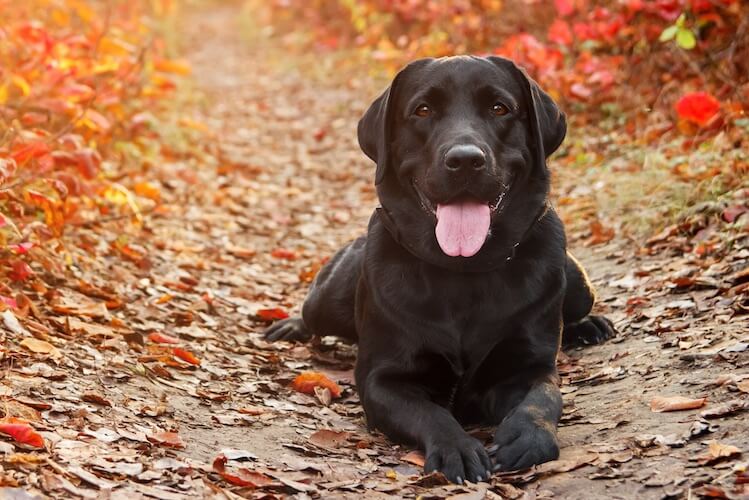
Labrador Retrievers date back to the 1800s in Britain. Ships trading from Labrador (Canada) brought these dogs into the United Kingdom via ports in the south of England.
This led to their now iconic name (the Labrador Retriever), as they were previously known as the “lesser Newfoundland”. Their name was changed to avoid confusion with Newfoundland dogs.
They became an instant hit, especially with noblemen and hunters. Through the later part of the 1800s, British lords and ladies refined and standardized the breed.
By 1903 the standard was complete and the dog was registered by the UK Kennel Club. In 1917, America followed suit, registering this dog breed with the American Kennel Club.
Despite being the same breed, the English and American bloodlines are slightly different. American siblings are known as working-line retrievers, while English variations are show-lines. This leads to subtle differences on their appearance with the American version being slightly taller and thinner.
They have remained ever popular; they became the most popular dog breed in America in 1991 and have claimed the title since, for 29 consecutive years!
The Labrador Retriever has been recognized by the American Kennel Club since 1917.
Fourteen years later, the National Retriever Club of America was founded in 1931, with a mission to preserve and promote the health and temperament of the breed.
| Size | 21 to 24.5 inches |
| Weight | 55 to 80 pounds |
| Lifespan | 10–14 years |
| Breed Type | Sporting Group |
| Purpose | Retrieving and Companion |
| Suitable For | Everyone |
| Color Variations | Black, Red, Chocolate, Yellow and Silver |
| Temperament | Friendly, Loving, Active, Sociable and Playful |
Temperament and Behavior
Labrador Retrievers are known for their kind and patient temperament. They are very easy-going dogs, more than happy to spend the day plodding around the house in between walks and cuddles.
This breed tends to be at their happiest when outdoors and so will happily spend their days napping in the garden. If you do not have a garden, be sure to take them on slightly longer walks to allow them to spend extra time outside.
Everything is an adventure to this dog. Whether you are just going to the shop or getting yourself another cup of coffee, a Lab will love to follow you on this grand adventure!
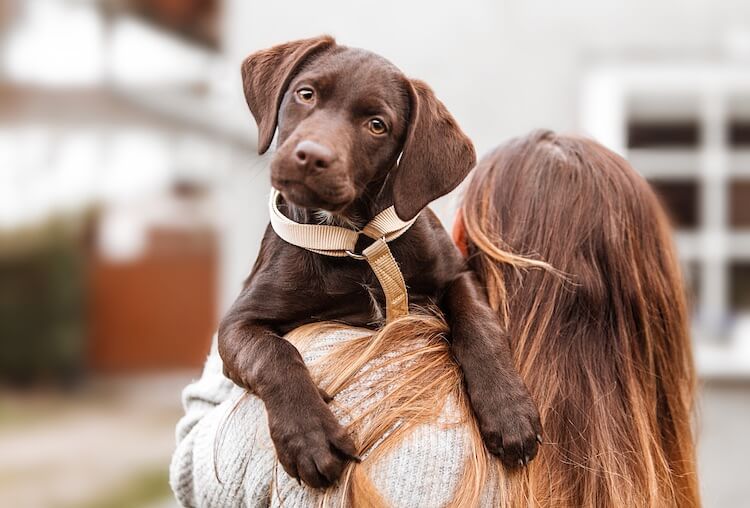
One thing to note about a Labrador Retriever’s behavior is that they love to chew!
Be sure to provide your dog with things that are acceptable to play with and chew, otherwise they may chew something you may not be so happy about (e.g. carpets, tables, chairs and furniture).
When puppy-proofing your home, make sure that all the cables are stowed away for your puppy’s safety.
If you are looking for a guard dog for your family, you have definitely found the wrong breed. Labrador Retrievers are very soft dogs, the most they would do to any intruder is cover them with kisses.
They are not known for having a competitive streak that you can see in other breeds (e.g. border collies), and as a result may not be as suitable for canine sports like flyball. However, as a fun pass-time they will definitely enjoy these sports and even some agility too!
Do They Make Good Family Dogs?
| Young Children | |
| Teenagers | |
| Seniors | |
| Other Pets |
Known as an excellent family dog, they are very patient and playful, especially with young children. They can thrive in a busy family home, slotting right into the average American suburban lifestyle.
Like all breeds of dog, Labrador Retrievers do have a breaking point. Therefore, if you are planning to keep your pet in a home with very young children, it is important to teach your children how to play with your dog, as well as teaching your dog how to interact with your children.
Compatible with most family lifestyles, the only pre-requisite is high activity levels! While they can make very good pets for senior citizens, any parent must be able to walk this dog regularly.
Labrador Retrievers are known to be very relaxed around other pets in the home (including other dogs).
Provided introductions are carried out properly, they can often be found cuddling up with feline friends too; though, this compatibility will depend entirely on the personality of both pets.
Care Guide

This is a family dog who loves to spend time in the great outdoors.
While he can do well in any home, he is best suited to homes where he can have a garden to run around and play in with the hubbub of a busy family environment.
How Much Should You Feed A Labrador Retriever
| Daily Food Consumption | |
|---|---|
| Guide | ~1,200 calories |
| Cups of Kibble | |
Labrador Retrievers are very well established as hungry dogs, known for their scavenging genes.
No matter how much you feed them, their puppy eyes will tell you that they are starving. Because of this learned behavior canine obesity is a concern for this breed.
A Labrador Retriever should eat up to 2 to 3 cups of high-quality kibble each day. This will vary slightly, depending on your dog’s size, activity level, and the quality of the food you decide to feed.
Ideally your dog should be having two meals of between 1 and 1.5 cups of kibble each day. When they are puppies, Labradors will need to eat slightly more frequently, eating between three and four times a day.
Their stomachs can be quite robust and consequently they can do well on a dry, raw or wet diet. If you wish to give your dog treats on top, try treating them with dog safe fruits and vegetables.
Exercise Requirements
| Daily Exercise | |
|---|---|
| Minutes | 60+ minutes |
| Activity Level | |
| Favorite Exercise | Swimming |
At their happiest when running through fields or swimming in a lake, this breed loves to be outdoors. They are even happy to just nap in a sunny spot on the grass!
Owners should try to exercise them for around one hour each day.
Like all dogs, Labradors can very quickly become frustrated and may begin to express behaviors such as chewing your expensive new shoes or excessive barking if not exercised enough.
To combat this, you should ensure your dog gets their hour of exercise each day, ideally split into a morning and afternoon walk to allow them their favorite pastime of being outdoors.
Labradors are very good at being selectively deaf, especially when on walks!
Despite being retrievers by nature, they are very good at being completely oblivious to their owner when there’s a dog to play with or a squirrel to chase. Because of this, owners will have to put a lot of effort into their recall training.
Training Advice
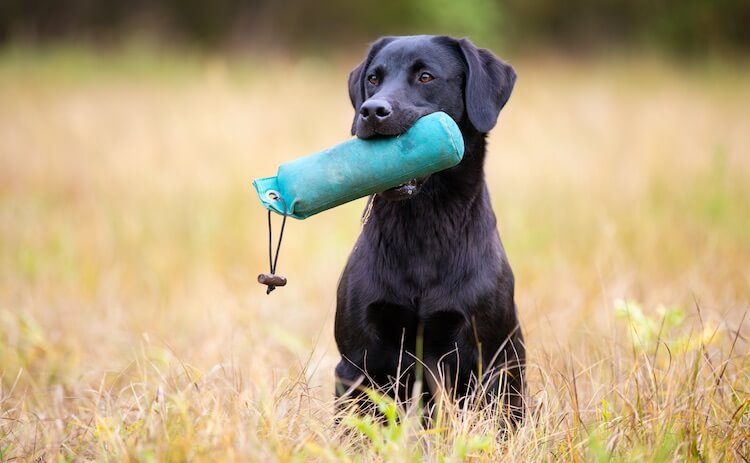
One of the reasons this dog is such a popular breed is their their patience and trainability. They do really well at training as many owners find out Labrador training is fairly easy.
They are often used as therapy and service dogs in a variety of different roles. As a result, owners should have no issues training their dog; even first-time owners too.
As they are very food-driven, Labrador Retrievers excel with a positive reinforcement training approach, whereby the dog is rewarded for the correct behavior. Try using a clicker with your dog to really hone in on their intelligence.
Make sure you do not use older, dominance-based methods or punishment-based training with your dog. This will damage your relationship wand bond, creating issues further down the line. Instead, use their natural desire to please you to your advantage by rewarding the correct behavior with food or play.
Grooming
As far as dog breeds go, the Labrador is considered to be very high shedding. They will shed continually all year round, with two big yearly “blow outs” where their winter and summer coats come in.
To combat their continual shedding, they will need brushing daily to remove the loose fur from their coat. Brushes and grooming gear should be introduced using positive reinforcement from puppyhood.
Choice-based games like the bucket-game will make grooming much easier.
The Labrador Retriever has a short, stiff coat that does not need grooming with clippers. It also does not need regular bathing, as this can dry out both the coat and the skin.
They only really need bathing when they have rolled in something stinky! When this happens, be sure to use a hypoallergenic shampoo and ensure that the coat is completely dry.
Nails will need clipping every six to eight weeks. This should be done by a professional, either a groomer or a veterinarian, in order to avoid injury.
Known Health Issues

Notorious for developing canine hip dysplasia, in a survey completed between 1974 and 2006, 12% of Labrador Retrievers had hip dysplasia, and this is estimated to have increased.
Hip dysplasia is a condition whereby an incorrect formation of the hip joint causes pain during movement:
- In severe cases, this can lead to osteoarthritis
- Milder cases of hip dysplasia are medicated using anti-inflammatory medication, whereby more severe cases are corrected using surgery
As well as hip dysplasia, this breed may also develop Elbow Dysplasia and Luxating Patellar. Similar to hip dysplasia, these orthopedic conditions can be treated either via anti inflammatory pain medication or surgery if more severe.
Canine bloat is another common issue in this dog. Bloat is characterized by the stomach filling with gas, and then twisting so the air cannot escape.
It is usually characterized by a swelling of the stomach, restlessness and panting/drooling. Canine bloat is a very serious condition and can kill if not treated immediately.
Nevertheless, most Labrador Retrievers live long and healthy lives, living between 10 and 14 years!
You may wish to take out a pet insurance plan for your dog. On average, owners pay between $35 and $52 USD per month to insure their Labrador. The price will vary slightly depending on the age, pedigree and health status.
Breed Appearance: Size, Color and Coat
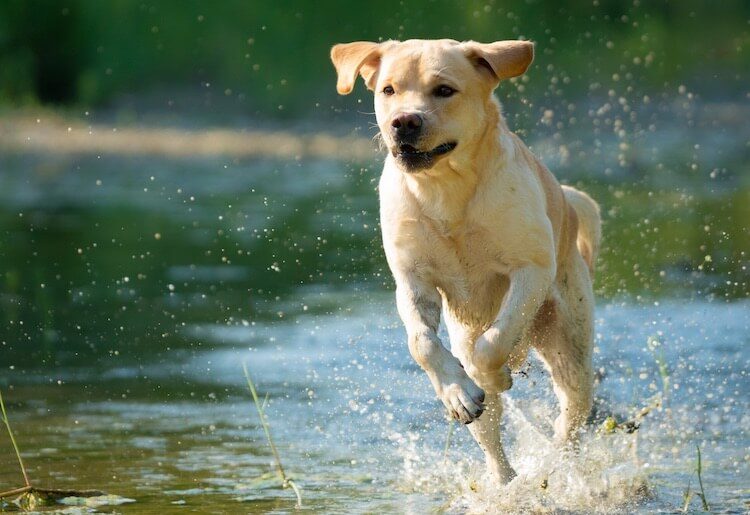
Labrador Retrievers are a very easily identified breed! A muscular and athletic dog, American Labradors are slightly more slender than the chunkier English Labradors.
They have square heads, long snouts, dark brown eyes and black noses.
One point of interest when it comes to the appearance of this dog is their tail. Described as an otter tail, their tail is thick and powerful, it is designed to assist with swimming as Labradors love to be in the water (most even have webbed paws).
How Big Do Labrador Retrievers Get?
Classified as a large dog by the American Kennel Club they stand between 21.5 and 24.5 inches tall and weigh between 55 and 80 pounds.
They are heavy set dogs and as with other breeds, females are slightly smaller than males.
Coat and Colors

Labrador Retrievers often come in three common types: the yellow (i.e. golden lab), chocolate Labrador, or a black Lab.
There are also two additional types, which are not recognized by the American Kennel Club: red and silver Labrador.
In terms of coat, they have a short, stiff, high shedding coat. It is always one block color which tends to be darker on the ears, snout, paws, groin and chest.
Puppy Advice
Adopting a Labrador Retriever puppy and bringing them into your home is great fun, they make a great match for family life and bring joy wherever they go. If you are thinking about getting a Lab puppy and can’t think of any names, here are some Labrador names to consider.
Like all breeds, Labrador puppies should come home at eight weeks of age. Any earlier than this and they will struggle, as they are not meant to be away from their mother before eight weeks (for many reasons).
On average, a litter will contain anywhere from six to eight puppies, although in some cases, it has been reported to have as many as 12 puppies!
How Much Do Labrador Retriever Puppies Cost?

The price will vary depending on where you get your puppy from, their parents’ health records, pedigree and coat color.
Generally speaking, they can cost anywhere between $400 and $2,000 USD.
Puppies with red and silver coats or from obedience, agility or showing bloodlines will be closer to $2,000.
Where To Adopt
Being the most popular breed in the country, this dog can be found in many places:
- If you are looking to adopt, a trip to your local rescue is a good place to start. More regularly than not, they will have a Labrador or mix available
- There are also Labrador specific rescue organizations set up for the purpose of rehoming, the largest of which is Lab Rescue
- If you are looking for a pedigree puppy, your best option is to look through the list of AKC registered breeders in your area.
When choosing a Labrador Retriever, it is very important to do your due diligence. Ask those who already own this breed about their experiences, especially with breeders.
Avoid shopping for puppies on websites such as GumTree or Facebook and always ask to see the puppies with mum.

Five Reasons Why We Love Labs
- Their world famous patient and loving temperament. Because of this, they are used all over the world as therapy dogs
- They have been the number one dog in America for 29 consecutive years
- Labradors are not actually from Labrador (Canada), but originate from a neighboring county called Newfoundland. They are simply named after the port where the ships set sail from!
- They have webbed feet; they love swimming
- Their short, stiff coat is water resistant which makes grooming simple (despite being time consuming)
Summary
These dogs have been a favorite since they were first named in the early 1900s. Originally breed as a fisherman’s dog, they have found themselves in many different roles and homes since then!
A simple life for Labrador Retrievers includes an hour exercising each day, a daily brush, two meals, naptime, playtime and cuddles! Before adopting you need to make sure your activity levels are high enough for this breed.
It doesn’t get more fun and loving than a Labrador Retriever.
The perfect family dog, let us know your thoughts in the comments below. Also, if you have this dog and want to share your experiences please let us know below.



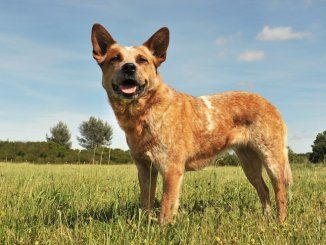
Thank you so much. A lot of good information. I have a labradoodle and he is more lab than doodle. You described him exactly. You answered my questions about health and joint problems.